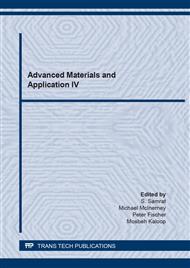[1]
Coelho, S.C., B.N. Estevinho, and F. Rocha, Encapsulation in food industry with emerging electrohydrodynamic techniques: Electrospinning and Electrospraying-A review. Food Chemistry, 2020: p.127850.
DOI: 10.1016/j.foodchem.2020.127850
Google Scholar
[2]
Attaalmanan, E.M., et al., The Biostability of Gold Nanoparticles for Cancer Treatment. Journal of Clinical Engineering, 2020. 45(1): pp.66-71.
Google Scholar
[3]
Sahani, S. and Y.C. Sharma, Advancements in applications of nanotechnology in global food industry. Food Chemistry, 2020: p.128318.
DOI: 10.1016/j.foodchem.2020.128318
Google Scholar
[4]
Yahya, I., et al., Polymeric Nanoparticles as Drug Delivery Systems for Controlled Release. Advanced Science, Engineering and Medicine, 2020. 12(2): pp.263-270.
Google Scholar
[5]
Anu Bhushani, J. and C. Anandharamakrishnan, Electrospinning and electrospraying techniques: Potential food based applications. Trends in Food Science & Technology, 2014. 38(1): pp.21-33.
DOI: 10.1016/j.tifs.2014.03.004
Google Scholar
[6]
Jafari, S.M., et al., Nano spray drying of food ingredients; materials, processing and applications. Trends in Food Science & Technology, (2021).
DOI: 10.1016/j.tifs.2021.01.061
Google Scholar
[7]
Yahya, I., et al., Utilization of solid lipid nanoparticles loaded anticancer agents as drug delivery systems for controlled release. International Journal of Engineering Applied Sciences and Technology, 2019. 3(12): pp.7-16.
DOI: 10.33564/ijeast.2019.v03i12.002
Google Scholar
[8]
Yahya, I., et al., Mathematical Modeling of Diffusion Controlled Drug Release Profiles from Nanoparticles. International Journal of Research and Scientific Innovation (IJRSI), 2019. 6(5): pp.287-291.
Google Scholar
[9]
Zhong, Q. and L. Zhang, Nanoparticles fabricated from bulk solid lipids: Preparation, properties, and potential food applications. Advances in colloid and interface science, 2019. 273: p.102033.
DOI: 10.1016/j.cis.2019.102033
Google Scholar
[10]
Chai, J., et al., The intelligent delivery systems for bioactive compounds in foods: Physicochemical and physiological conditions, absorption mechanisms, obstacles and responsive strategies. Trends in Food Science & Technology, 2018. 78: pp.144-154.
DOI: 10.1016/j.tifs.2018.06.003
Google Scholar
[11]
Ahmed, L., I. Yahya, and M. Eltayeb. Computational Modeling of Drug Release Profiles from Swellable Polymeric Nanoparticles. in 2019 International Conference on Computer, Control, Electrical, and Electronics Engineering (ICCCEEE). 2019. IEEE.
DOI: 10.1109/iccceee46830.2019.9070894
Google Scholar
[12]
Atif, R., I. Yahya, and M. Eltaye, Simulation of Drug Release from Biodegradable and Erodible Polymers. 2019 International Conference on Computer, Control, Electrical, and Electronics Engineering (ICCCEEE), 2019: pp.1-6.
DOI: 10.1109/iccceee46830.2019.9071247
Google Scholar
[13]
Eltayeb, M., E. Stride, and M. Edirisinghe, Electrosprayed core-shell polymer-lipid nanoparticles for active component delivery. Nanotechnology, 2013. 24(46): p.465604.
DOI: 10.1088/0957-4484/24/46/465604
Google Scholar
[14]
Eltayeb, M., et al., Preparation of solid lipid nanoparticles containing active compound by electrohydrodynamic spraying. Food Research International, 2013. 53(1): pp.88-95.
DOI: 10.1016/j.foodres.2013.03.047
Google Scholar
[15]
Crucho, C.I. and M.T. Barros, Polymeric nanoparticles: A study on the preparation variables and characterization methods. Materials Science and Engineering: C, 2017. 80: pp.771-784.
DOI: 10.1016/j.msec.2017.06.004
Google Scholar
[16]
Eltayeb, M., et al., Electrosprayed nanoparticle delivery system for controlled release. Materials Science and Engineering: C, 2016. 66: pp.138-146.
DOI: 10.1016/j.msec.2016.04.001
Google Scholar
[17]
Eltayeb, M., E. Stride, and M. Edirisinghe, Preparation, characterization and release kinetics of ethylcellulose nanoparticles encapsulating ethylvanillin as a model functional component. journal of functional foods, 2015. 14: pp.726-735.
DOI: 10.1016/j.jff.2015.02.036
Google Scholar
[18]
Li, X. and T. Yang, Fabrication of ethyl cellulose microspheres: Chitosan solution as a stabilizer. Korean Journal of Chemical Engineering, 2008. 25(5): pp.1201-1204.
DOI: 10.1007/s11814-008-0198-8
Google Scholar


